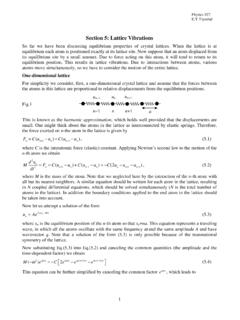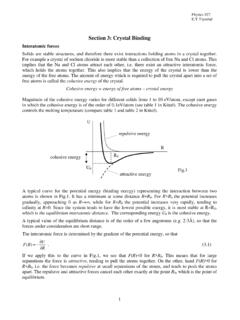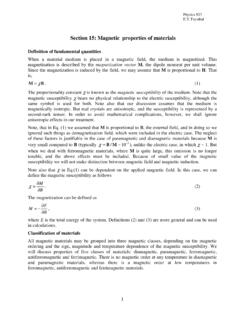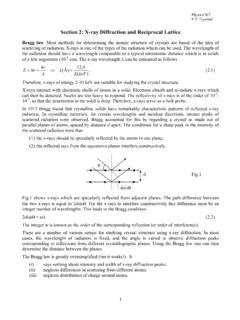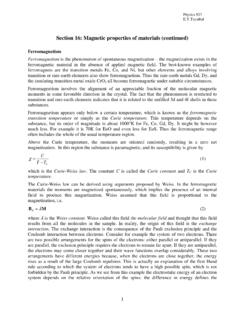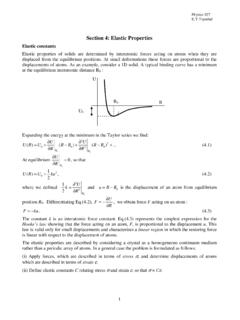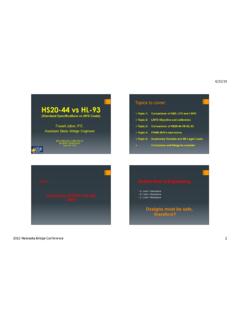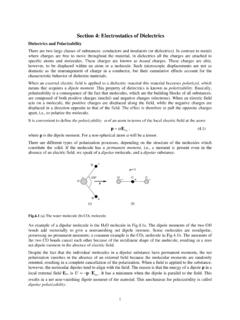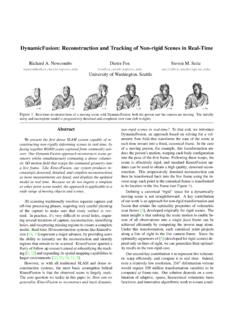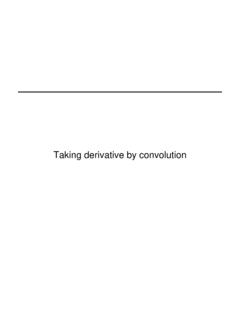Transcription of Section 1: Crystal Structure
1 Physics 927 1 Section 1: Crystal Structure A solid is said to be a Crystal if atoms are arranged in such a way that their positions are exactly periodic. This concept is illustrated in using a two-dimensional (2D) Structure . A perfect Crystal maintains this periodicity in both the x and y directions from - to + . As follows from this periodicity, the atoms A, B, C, etc. are equivalent. In other words, for an observer located at any of these atomic sites, the Crystal appears exactly the same. The same idea can be expressed by saying that a Crystal possesses a translational symmetry. The translational symmetry means that if the Crystal is translated by any vector joining two atoms, say T in , the Crystal appears exactly the same as it did before the translation.
2 In other words the Crystal remains invariant under any such translation. The Structure of all crystals can be described in terms of a lattice, with a group of atoms attached to every lattice point. For example, in the case of Structure shown in , if we replace each atom by a geometrical point located at the equilibrium position of that atom, we obtain a Crystal lattice. The Crystal lattice has the same geometrical properties as the Crystal , but it is devoid of any physical contents. There are two classes of lattices: the Bravais and the non-Bravais. In a Bravais lattice all lattice points are equivalent and hence by necessity all atoms in the Crystal are of the same kind. On the other hand, in a non-Bravais lattice, some of the lattice points are non-equivalent. In the lattice sites A, B, C are equivalent to each other.
3 Also the sites A1, B1, C1, are equivalent among themselves. However, sites A and A1 are not equivalent: the lattice is not invariant under translation AA1. A B C A1 B1 C1 y x A B C a1 T Physics 927 2 Non-Bravais lattices are often referred to as a lattice with a basis. The basis is a set of atoms which is located near each site of a Bravais lattice. Thus, in the basis is represented by the two atoms A and A1. In a general case Crystal Structure can be considered as Crystal Structure = lattice + basis. The lattice is defined by fundamental translation vectors. For example, the position vector of any lattice site of the two dimensional lattice in can be written as T=n1a1+n2a2 , ( ) where a1 and a2 are the two vectors shown in , and n1,n2 is a pair of integers whose values depend on the lattice site.
4 So, the two non-collinear vectors a1 and a2 can be used to obtain the positions of all lattice points which are expressed by Eq.(1). The set of all vectors T expressed by this equation is called the lattice vectors. Therefore, the lattice has a translational symmetry under displacements specified by the lattice vectors T. In this sense the vectors a1 and a2 can be called the primitive translation vectors. The choice of the primitive translations vectors is not unique. One could equally well take the vectors a1 and a = a1+a2 as primitive translation vectors (see ). This choice is usually dictated by convenience. Unit cell. In the case of a rectangular two dimensional lattice the unit cell is the rectangle, whose sides are the vectors a1 and a2. If the unit cell is translated by all the lattice vectors expressed by Eq.
5 (1), the area of the whole lattice is covered once and only once. A primitive unit cell is the unit cell with the smallest area which produces this coverage. In the two dimensional case the area of the unit cell is given by S=|a1 a2|. The choice of the unit cell is not unique. For example, the parallelogram formed by the vectors a1 and a in is also an acceptable unit cell. The choice is again dictated by convenience. The area of the unit cell based on vectors a1 and a2 is the same as that based on vectors a1 and a. Wigner-Seits unit cell. The primitive cell may be chosen as shown in (i) Draw lines to connect a given lattice point to all nearby lattice points. (ii) At the midpoint and normal to these lines, draw new lines (planes in 3D). The smallest volume enclosed is the Wigner- seitz primitive cell.
6 All the space of the Crystal may be filled by these primitive cells, by translating the unit cell by the lattice vectors. y x a1 a2 a T Physics 927 3 The unit cell can be primitive and non-primitive (or conventional). The unit cell discussed above is primitive. However, in some cases it is more convenient to deal with a unit cell which is larger, however, it exhibits the symmetry of the lattice more clearly. Vectors a1 and a2 can be chosen as primitive translation vectors for the lattice shown in In this case the unit sell is parallelogram. However, the lattice can also be regarded as adjacent rectangles, where the vectors c1 and c2 can be considered as primitive translation vectors. The unit cell in this case is larger, however it exhibits the rectangular symmetry more clearly.
7 In the first case we have just one atom in a unit cell, whereas in the second case we have a lattice with a basis. The basis consists of the two atoms: one atom is located in the corner of the unit cell and another atom in the center of the unit cell. The area of the conventional unit cell is larger by a factor of two than the area of the primitive unit cell. Crystal lattices are classified according to their symmetry properties, such as inversion, reflection and rotation. Inversion center. A cell has an inversion center if there is a point at which the cell remains invariant under transformation r -> -r. All the Bravais lattices are inversion symmetric. Non-Bravais lattices may or may not have an inversion center depending on the symmetry of the basis. Reflection plane. A cell has a reflection plane if it remains invariant when a mirror reflection in this plane is performed.
8 Rotation axis. This is an axis such that, if the cell rotated around the axis trough some angle, the cell remains invariant. The axis is called n-fold if the angle of rotation is 2 /n. Only 2-, 3-, 4-, and 6-fold axes are possible. There are five Bravais lattice types in two dimensions shown in For each of them the rotation axes and/or mirror planes occur at the lattice points. However, there are other locations in the unit cell with comparable or lower degrees of symmetry with respect to rotation and reflection. For non-Bravais lattices we have to take into account the symmetry of the basis which is referred as point-group symmetry. The point group symmetry includes all possible rotations, reflections and inversion, which leave the basis invariant. Point groups are denoted by a numerical and m.
9 The numerical indicates how many positions within the basis are equivalent by rotation symmetry. A single m shows that the basis has a mirror plane symmetry. (In two dimensions it is mirror axis). , 3m means that there are 3 equivalent sites within the unit cell and there is one mirror plane. In two dimensions there are 10 point groups. When we combine the rotation symmetry of the point group with the transnational symmetries, we obtain a space-group symmetry. c1 c2 a1 a2 Physics 927 4 Physics 927 5 All the lattice properties we discussed for two dimensions can be extended to three dimensions. The lattice vectors are in this case T=n1a1+n2a2+n3a3 ( ) where a1, a2 and a3 are the primitive translation vectors, and (n1,n2,n3) are a triplet of integers whose values depend on a particular lattice site.
10 The unit cell in three dimensions is a parallelepiped, whose sides are the primitive translation vectors (see ). Here again the choice of the unit cell is not unique, although all primitive unit cells have equal volumes. The unit cell fills all space by the repetition of Crystal translation operations. The volume of the unit cell represented by a parallelepiped with sides a1, a2 and a3 is given by V=|a1 a2 a3|. ( ) Also, it is sometimes more convenient to deal with non-primitive or conventional cells, which have additional lattice sites either inside the cell or on its surface. In three dimensions there are 14 different Bravais Crystal lattices which belong to 7 Crystal systems. These systems are triclinic, monoclinic, orthorhombic, tetragonal, cubic, hexagonal and trigonal.
